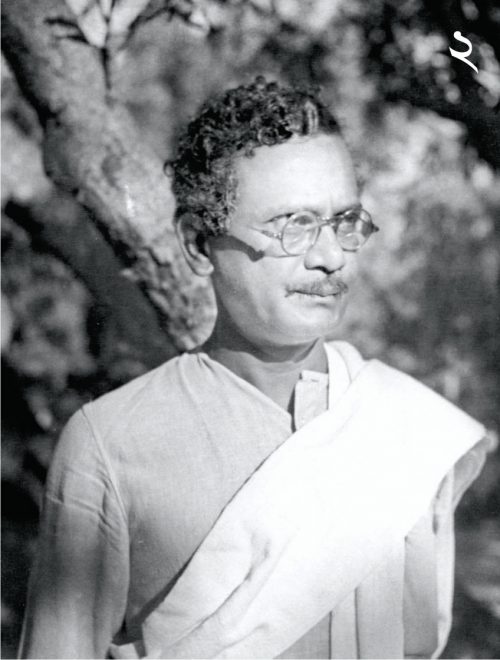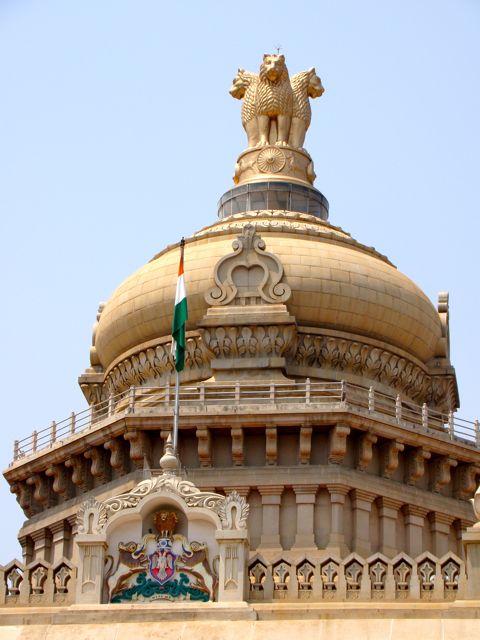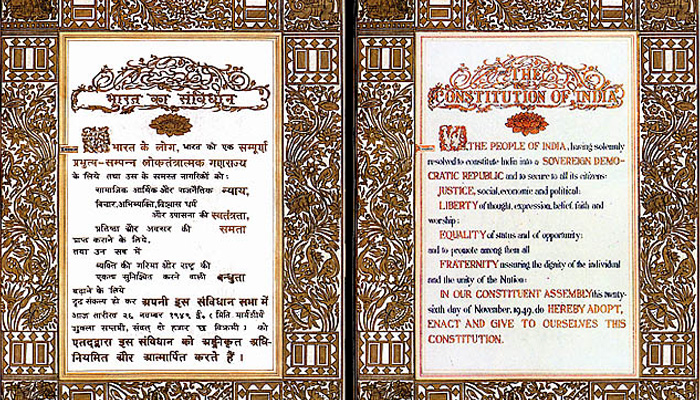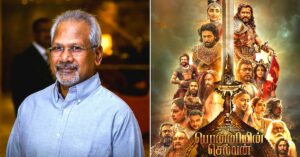A Tribute to the Artist who Sketched and Illuminated India’s National Emblem
The man who sketched and illuminated India's national emblem, the Lion Capital of Ashoka, Dinanath Bhargava's work also adorns the front pages of the original manuscript of the Indian Constitution.

Next time you see the national emblem of India, think of a young artist shuttling a hundred kilometres a day for about a whole month, braving the crowds, dust and grime of 1940s Kolkata, to study live lions for the design of India’s national emblem.
Dinanath Bhargava, who died at the age of 89 in Indore yesterday, is the man who sketched and illuminated India’s national emblem, the Lion Capital of Ashoka. His work also adorns the front pages of the original manuscript of the Indian Constitution.

Photo Source
Born on November 1, 1927, Dinanath Bhargava belonged to the small town of Multai in Betul district of Madhya Pradesh. When India gained independence in 1947, he was in his early 20s and was pursuing 3-year Diploma in Fine Arts at Shantiniketan.
You May Like: #Travel Tales: Exploring Tagore’s Santiniketan, an Abode of Learning Unlike Any in the World
It was at Shantiniketan that he first met the noted painter, Nandlal Bose (then the Principal of Kala Bhavan Shanti Niketan). Impressed by Bhargava’s talent, Bose handpicked him as a member of the group responsible for designing the pages of the Indian Constitution’s manuscript.
Photo Source
It was not an easy task. Bose was very particular about wanting the lions in the emblem to look exactly like the live ones. For about a month, every day, Bhargava commuted from Shantiniketan to the Kolkata zoo (about 100 km away), just to study the live lions, their mannerisms, countenance, body language etc.
It was only after Nandlal Bose was satisfied with his initial sketches that he gave Bhargava the big task: Designing the emblem for the first page of the Constitution. On 26 January 1950, India adopted Bhargava’s design, the Lion Capital of Ashoka, as the national emblem.

Photo Source
A close replica of Sarnath Lion capital, which was erected by Emperor Ashoka in 250 BC, India’s national emblem has four lions (one hidden from view) – symbolising power, courage and confidence – resting on a circular abacus. The abacus is girded by four smaller animals regarded as guardians of the four directions; the lion of the North, the elephant of the East, the horse of the South and the bull of the West. Each of these animals is separated by intervening wheels of Dharma Chakras (eternal wheels of law). The motto ‘Satyameva Jayate‘, meaning ‘truth alone triumphs’, is inscribed below the emblem in Devanagari script.
Bose also gave Bhargava the responsibility of decorating the first 30 pages of the Constitution’s first copy. The responsibility of the other pages were given to other artists in the group who were all students of Bose.
Designed with pencil and brush, each of the 30-odd pages of the constitution were filled with gold calligraphic text. Other than using colours made from stones to illuminate the text beautifully, the artists also used a spray of gold (prepared by mixing pure gold powder with wild-gum and babul) to touch up the pages. Special attention was paid to ensure that all the designs used in the manuscript imbibed the essence and spirit of the Indian art traditions.

Photo Source
Bhargava later recalled how he never saw a complete version of the manuscript back then as each time a section of the volume was complete, Nandlal Babu would sent the copy to Delhi. He finally did see it in 2006 ; some 58 years later, at the Lalit Kala Akademi.
Dinanath Bhargava is also renowned for his outstanding wash paintings. Wash painting is a technique in which a paint brush, that is very wet with solvent and holds a small load of paint or ink, is applied to a wet or dry support such as paper or primed or raw canvas. The result is a smooth and uniform area that ideally lacks the appearance of brush strokes and is semi-transparent.
Bhargava is also credited to have brought Madhubani paintings on cloth. As the director of All India Handloom Board till his retirement in 1986, he was also instrumental in introducing the double decker loom and designing new Chanderi saris. He also started the carpet-making industry in Gwalior and was honoured by the Madhya Pradesh government for his contribution to the Indian world of art and crafts.
His paintings were also displayed in the Europe’s world art tour in the 1950’s, in which he won the gold medal but Bhargava remained untouched by all the fame. A humble man who truly loved his craft, he rarely sold any of his paintings. Throughout his life, the possession he valued most was his painting, ‘Splendour of the Moon’ that his teacher Nandlal Bose had signed for him, congratulating his work. With his death, India did not just lose one of its best artists, it lost the man gave the nation its iconic emblem.
Also Read: #TravelTales: Exploring Naya, Bengal’s Village of Singing Painters
Like this story? Have something to share? Email: contact@thebetterindia.
NEW! Log into www.gettbi.com to get positive news on Whatsapp.
This story made me
- 97
- 121
- 89
- 167
Tell Us More
We bring stories straight from the heart of India, to inspire millions and create a wave of impact. Our positive movement is growing bigger everyday, and we would love for you to join it.
Please contribute whatever you can, every little penny helps our team in bringing you more stories that support dreams and spread hope.



















